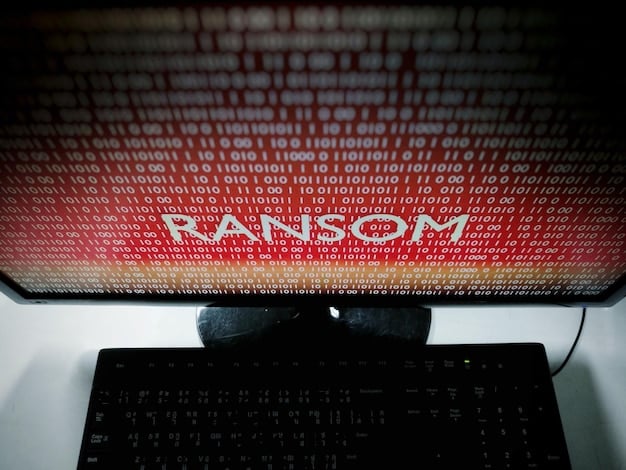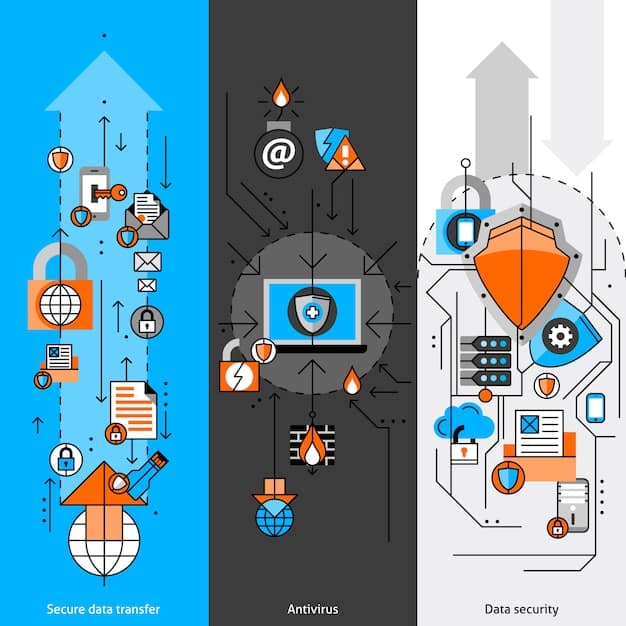Cybersecurity Insurance Premiums: How to Reduce Risk & Costs

Cybersecurity insurance premiums are skyrocketing due to increased cyber threats; businesses can reduce risk and save money by implementing robust security measures, training employees, and regularly updating their insurance policies.
Rising cyber threats are causing cybersecurity insurance premiums to skyrocket, creating a significant financial burden for businesses. However, by understanding the key drivers behind these increases and implementing proactive cybersecurity measures, companies can reduce their risk profile and potentially lower their insurance costs.
Understanding the Surge in Cybersecurity Insurance Premiums
The cybersecurity landscape is constantly evolving, and with it, the cost of insuring against cyber threats is also on the rise. Understanding the factors driving this increase is the first step toward managing your cybersecurity insurance expenses.
The Growing Threat Landscape
The frequency and sophistication of cyberattacks are increasing, making businesses more vulnerable. This heightened risk directly translates to higher premiums.
Ransomware Attacks
Ransomware remains a significant threat, causing substantial financial losses and business disruptions. Insurance companies are paying out more claims related to ransomware, leading to increased premiums.

Compliance Requirements
Stringent data privacy regulations like GDPR and CCPA require businesses to invest in robust cybersecurity measures. Failure to comply can result in hefty fines, which insurers factor into premiums.
In summary, the convergence of these factors is driving up the cost of cybersecurity insurance. Businesses need to understand this landscape to take proactive steps.
Assessing Your Current Cybersecurity Posture
Before seeking cybersecurity insurance or trying to reduce premiums, it’s crucial to assess your current cybersecurity posture. This assessment will identify vulnerabilities and areas for improvement.
Conducting a Risk Assessment
A comprehensive risk assessment identifies potential threats and vulnerabilities in your IT infrastructure. This helps prioritize security investments and improve your overall security.
Vulnerability Scanning and Penetration Testing
Regular vulnerability scans and penetration testing can highlight weaknesses in your systems and applications. Addressing these weaknesses can significantly reduce your risk profile.
- Identify critical assets
- Analyze potential threats
- Determine the likelihood and impact of each threat
- Prioritize risks based on severity
Assessing your cybersecurity posture provides the foundation for a strong security strategy and can influence your insurance premiums.
Implementing Robust Cybersecurity Measures
Implementing robust cybersecurity measures is the most effective way to reduce your risk profile and potentially lower your cybersecurity insurance premiums. A multi-layered approach is essential for comprehensive protection.
Endpoint Protection and Antivirus Software
Robust endpoint protection and antivirus software are the first line of defense against malware and other threats. Ensure your systems are regularly updated.
Firewalls and Intrusion Detection Systems
Firewalls and intrusion detection systems monitor network traffic for malicious activity and prevent unauthorized access.

Multi-Factor Authentication (MFA)
Implementing MFA adds an extra layer of security by requiring users to provide multiple forms of identification. This significantly reduces the risk of unauthorized access.
By implementing these measures, businesses can significantly reduce their risk of cyberattacks and potentially lower their insurance premiums.
The Importance of Employee Training
Employees are often the weakest link in a cybersecurity defense. Comprehensive employee training is essential to mitigate this risk and protect your business.
Phishing Awareness Training
Phishing attacks are a common way for cybercriminals to gain access to sensitive information. Training employees to recognize and avoid phishing attempts is crucial.
Password Security Best Practices
Educate employees on creating strong, unique passwords and avoiding password reuse. Encourage the use of password management tools.
Incident Response Training
Train employees on how to respond to a security incident, including reporting suspicious activity and following established protocols.
- Regular training sessions
- Simulated phishing attacks
- Reinforcement of security policies
Investing in employee training is a cost-effective way to improve your cybersecurity posture and potentially lower your insurance costs.
Working with Your Insurance Provider
Maintaining open communication with your insurance provider is essential. Understanding their requirements and seeking their advice can help you optimize your cybersecurity insurance policy.
Understanding Policy Requirements
Review your cybersecurity insurance policy carefully to understand the coverage limits, exclusions, and requirements.
Sharing Security Assessments
Share your security assessments and improvement plans with your insurance provider. This demonstrates your commitment to reducing risk and may result in lower premiums.
Regular Policy Review
Review your policy regularly to ensure it continues to meet your business needs and reflects any changes in your cybersecurity posture.
Working collaboratively with your insurance provider can lead to better coverage and potentially lower premiums.
Staying Up-to-Date with Cybersecurity Trends
The cybersecurity landscape is constantly changing. Staying informed about the latest threats and vulnerabilities is essential for maintaining a strong security posture and managing your insurance costs.
Subscribing to Security Newsletters and Alerts
Subscribe to reputable security newsletters and alerts to stay informed about emerging threats and best practices.
Attending Industry Conferences and Webinars
Attend industry conferences and webinars to learn from experts and network with other professionals.
Implementing Security Updates and Patches
Regularly apply security updates and patches to your systems and applications to address known vulnerabilities.
- Continuous monitoring of the threat landscape
- Proactive adaptation to new threats
- Regular review of security measures
By staying informed and proactive, you can minimize your risk and potentially lower your cybersecurity insurance premiums.
| Key Aspect | Brief Description |
|---|---|
| 🛡️ Risk Assessment | Identify vulnerabilities and potential threats to prioritize security efforts. |
| 🧑💻 Employee Training | Educate staff on phishing, password security, and incident response. |
| 🔒 MFA Implementation | Add an extra security layer by requiring multiple forms of identification. |
| 📊 Policy Review | Regularly review your cybersecurity insurance policy and adjust your coverage. |
Frequently Asked Questions (FAQ)
▼
Premiums are increasing due to the escalating frequency and sophistication of cyberattacks, especially ransomware, impacting businesses and driving up insurance claims.
▼
A risk assessment identifies potential threats and vulnerabilities in your infrastructure. It’s crucial for prioritizing security investments and lowering your overall risk profile.
▼
Well-trained employees are less likely to fall victim to phishing and other social engineering attacks, reducing claims and potentially lowering insurance costs.
▼
MFA requires multiple forms of verification, adding a critical layer of security. This significantly reduces unauthorized access and bolsters your security defenses.
▼
You should review your policy regularly, ideally annually or when significant changes occur in your business operations or threat landscape, to ensure adequate coverage.
Conclusion
Managing the rising cost of cybersecurity insurance requires a proactive and comprehensive approach. By implementing robust security measures, training employees, and maintaining open communication with your insurance provider, you can reduce your risk profile and potentially lower your insurance premiums, safeguarding your business from evolving cyber threats.





